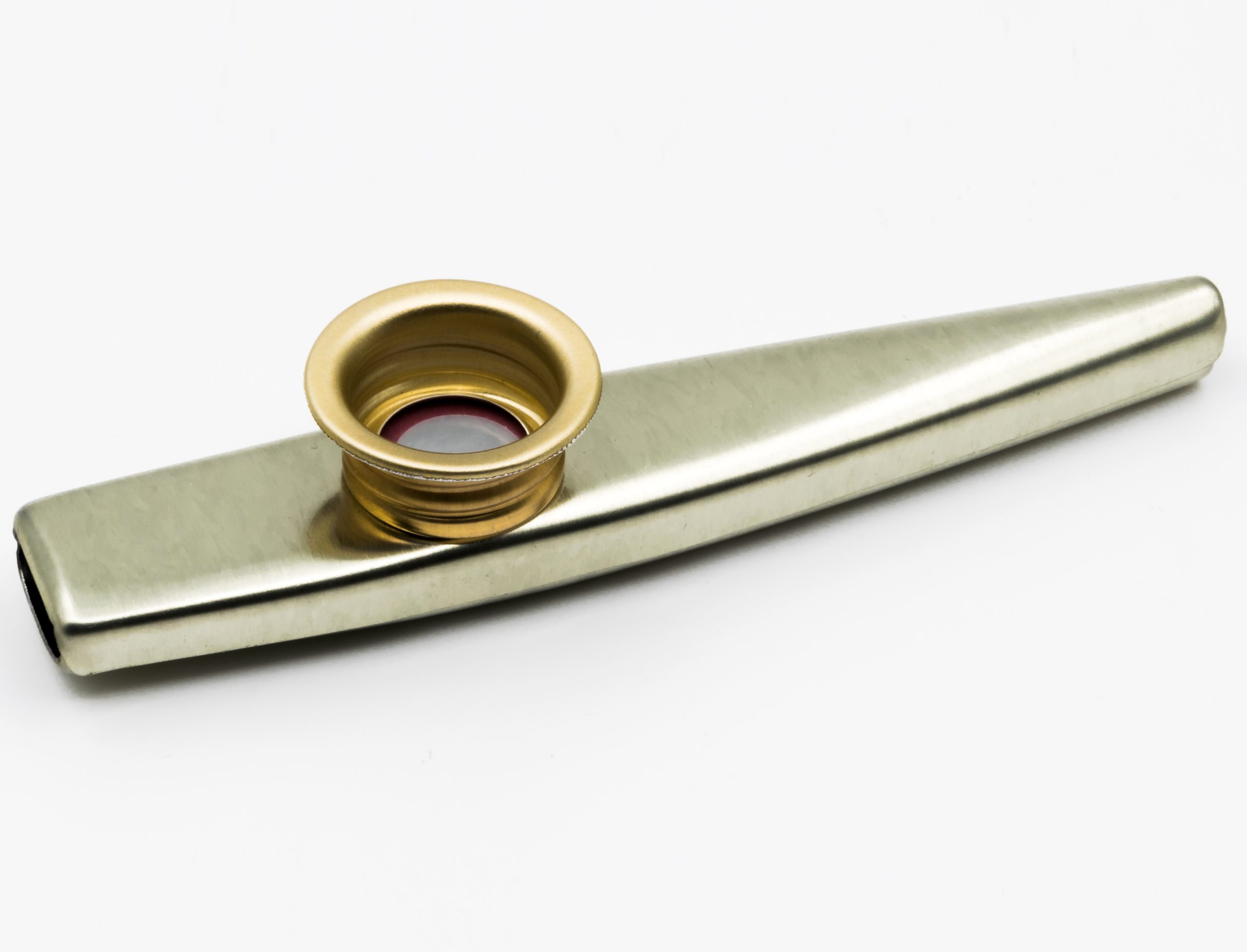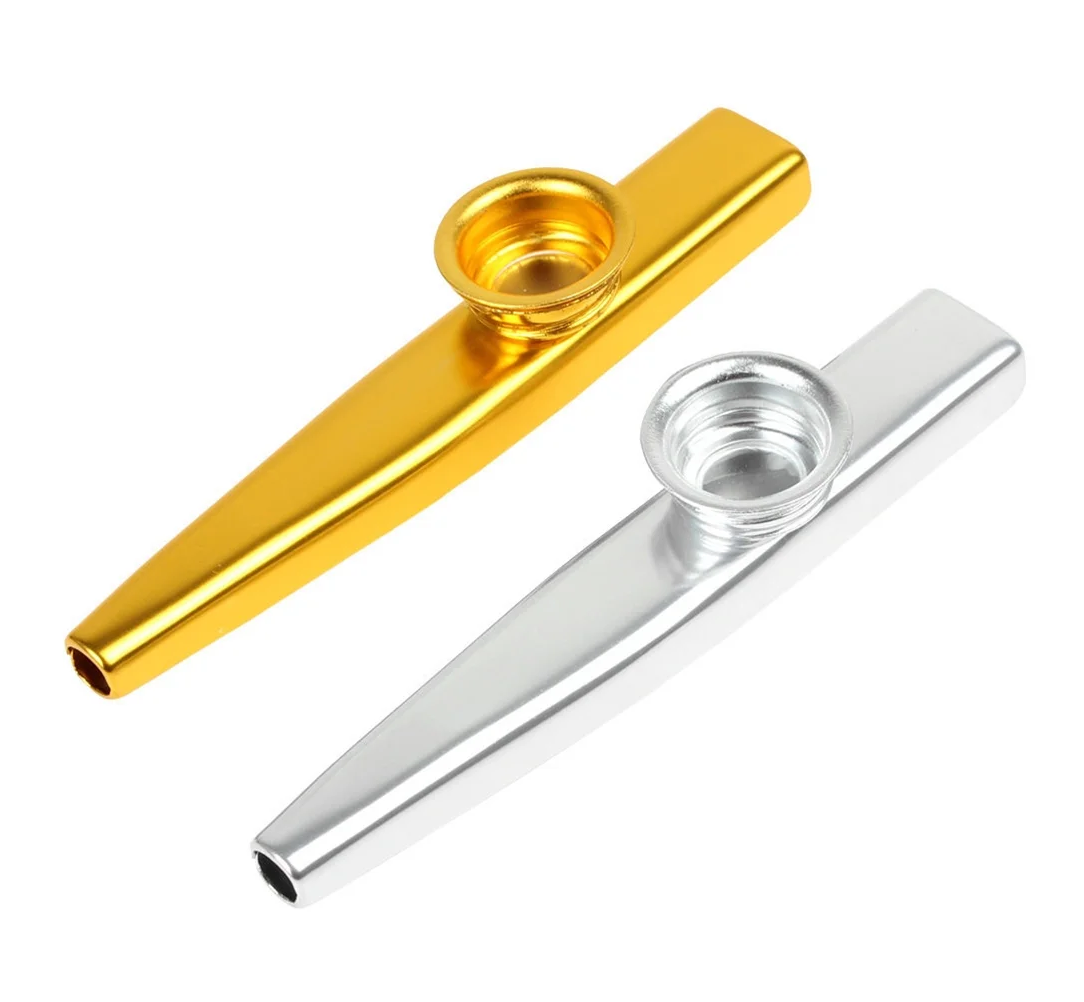Kazoo
Woodwinds
America
Between 1001 and 1900 AD
Video
The kazoo is a small, tube-shaped musical instrument known for its distinctive buzzing sound. It is a simple membranophone that modifies a player’s humming or vocalization into a nasally, resonant tone. Unlike traditional wind instruments that rely on airflow to produce sound, the kazoo works by vibrating a thin membrane in response to a musician’s voice. This instrument is easy to play, making it popular among children, amateur musicians, and professionals alike. The kazoo has a whimsical and comedic reputation, yet it has also found its place in various musical genres, including jazz, blues, and even rock.
Type of Instrument: The kazoo belongs to the category of membranophones, a subgroup of percussion instruments. While often mistaken for a woodwind instrument, the kazoo does not produce sound by air vibrations alone but rather through the interaction of a player’s voice with a vibrating membrane. Unlike brass or woodwind instruments, which rely on airflow manipulation, the kazoo modifies human vocalization, acting as an amplifier and tonal modifier rather than generating its own notes.
History
The kazoo has an intriguing and somewhat debated history. The instrument’s origins can be traced to Africa, where similar membranophones have been used for centuries in ceremonies and rituals. Instruments like the mirliton, which functioned on the same principle as the kazoo, were often crafted from natural materials such as gourds and animal hides. The modern kazoo, however, was developed in the United States in the 19th century. The first recognized version was created by Alabama Vest, an African American from Macon, Georgia, in the 1840s. He worked alongside Thaddeus Von Clegg, a German clockmaker, to refine the design into what is now recognized as the standard kazoo. The instrument gained popularity at the 1852 Georgia State Fair and continued to evolve over the years.
In 1902, the first metal kazoo was patented by George D. Smith. However, it was in 1916 that the kazoo saw widespread commercialization when Emil Sorg and Michael McIntyre established a factory in Eden, New York, producing metal kazoos on a larger scale. Since then, the kazoo has become an enduring part of musical history, used in various genres and settings.
Materials Used in Making Kazoos
Kazoos are made from a variety of materials, each affecting the instrument’s tone and durability. The most common materials include:
Metal: Produces a sharper, more resonant sound and is often used in high-quality kazoos.
Plastic: Lightweight and affordable, commonly used for children’s versions and casual play.
Wood: Offers a warmer, mellower sound and is sometimes preferred by professional musicians.
Resin and Composites: Some modern kazoos incorporate advanced materials for unique tonal qualities and enhanced durability.
Characteristics an types of the Kazoo
The kazoo is a small, membranophone wind instrument that modifies the player’s voice by adding a buzzing, distorted quality. It consists of a tube, often made of metal or plastic, with a thin membrane that vibrates when the player hums into it. Unlike traditional wind instruments, the kazoo does not produce sound through lip buzzing or a reed; instead, it amplifies and alters vocalized sounds. This gives it a distinctive, nasal, and buzzy tone. In music, the kazoo is often used for comic or novelty effects, adding a playful and whimsical quality to performances. It is commonly found in jazz, folk, and jug band music, as well as in children’s music due to its simplicity and ease of use. Despite its informal nature, the kazoo serves as a unique tool for vocal transformation and rhythmic accompaniment in various musical styles.
Types of Kazoos Kazoos come in different shapes and sizes, each offering distinct characteristics. The most notable types include:
Standard Kazoo: The classic tube-like kazoo with a single membrane.
Electric Kazoo: Equipped with a pickup that allows amplification and effects processing.
Trombone Kazoo: Features an adjustable slide, mimicking the trombone’s ability to modify pitch.
Submarine Kazoo: A novelty variation with a more pronounced body shape and different tonal properties.
Professional Kazoo: Crafted with higher-quality materials for better resonance and durability.
Sound Production
Unlike traditional wind instruments that rely on blowing air, the kazoo works by altering vocal sounds. The player hums or speaks into the kazoo, causing the membrane inside the instrument to vibrate. These vibrations create the kazoo’s signature buzzing tone, which changes in pitch and intensity based on the player’s vocal input. The quality and material of the membrane significantly influence the tone, with thinner membranes producing a sharper sound and thicker ones yielding a deeper resonance.
Playing Methods
The kazoo is a simple yet fun instrument that is played by humming or singing into it rather than blowing air like many other wind instruments. To play the kazoo, the player places their mouth over the larger hole, ensuring that the membrane (usually made of wax paper or plastic) is in place. The most essential aspect of playing the kazoo is the vocal sound. When you hum, sing, or talk into the kazoo, the vibrations of your voice cause the membrane to vibrate, producing the characteristic buzzing sound. The pitch and tone of the kazoo are determined by how hard or softly you hum, as well as the range of your voice. Players can experiment with different pitches, tones, and rhythms to create a variety of effects. Although the kazoo is easy to play, it requires little skill beyond control of the vocal sound, making it a fun and accessible instrument for both beginners and experienced musicians alike. Unlike other instruments, the kazoo doesn’t require any finger movements or complex techniques, making it a lighthearted addition to group performances or casual musical gatherings.
The basic steps include:
- Holding the kazoo: Grasp the kazoo with one or both hands, ensuring the larger opening is placed near the mouth.
- Humming into the kazoo: Instead of blowing, the player must hum, sing, or make vocal sounds.
- Controlling pitch and volume: The player can modify sound by adjusting their humming intensity and vocal pitch.
- Adding effects: By covering or uncovering the kazoo’s membrane hole, players can create variations in tone and resonance.
Roles in Music
The kazoo plays a unique and playful role in music, adding a distinctive buzzing or nasal tone to various musical genres. As a wind instrument that modifies the player’s voice, it is often used for humorous or novelty effects in performances, making it a popular choice in jazz, blues, folk, and even early rock music. Its simple construction and ease of play make it accessible to musicians and non-musicians alike, allowing it to serve as a fun and expressive addition to both professional and amateur music-making. In jazz and jug band music, the kazoo is frequently used as an alternative to brass instruments, mimicking the timbre of a trumpet or trombone. It also appears in children’s music and experimental compositions, where its quirky sound contributes to a lighthearted or avant-garde atmosphere. While not typically considered a serious solo instrument, the kazoo’s ability to transform humming into a vibrant, buzzing melody makes it a valuable tool for adding texture and character to musical arrangements.
Cultural Significance
The kazoo holds a unique place in musical culture, celebrated for its simplicity, accessibility, and playful sound. Originating from African mirlitons and later patented in the United States in the 19th century, the kazoo became a symbol of folk and popular music. It has played a significant role in American jazz, blues, and novelty music, often adding a whimsical or humorous element to performances. The kazoo’s ability to distort and amplify the human voice makes it a versatile instrument in both professional and amateur settings, allowing musicians of all skill levels to participate in musical expression. Beyond entertainment, it has been used in marching bands, children’s music education, and even political satire, demonstrating its broad cultural reach. In some traditions, similar instruments have been used in ceremonies and storytelling, emphasizing the kazoo’s deep-rooted connection to communal music-making. Despite its humble status, the kazoo remains an enduring symbol of creativity and inclusivity in music across various cultures.
In popular culture, the kazoo has been featured in comedy sketches, children’s programs, and viral internet videos. Its association with humor and whimsy makes it a favorite for informal and educational settings. Despite its simple design, the kazoo remains a beloved instrument with a rich history and enduring appeal.
FAQ
What is a kazoo and how does it work?
A kazoo is a small membranophone that modifies the player's voice through a vibrating membrane. Humming into it creates a buzzing sound by altering vocal vibrations.
What materials are kazoos made of?
Kazoos are typically made from plastic, metal, or wood. The material affects the tone, with metal kazoos producing a sharper sound and wooden ones offering a softer timbre.
What genres of music use the kazoo?
Kazoos are used in jazz, folk, blues, and novelty music. Their playful sound makes them popular in comedic performances and early jazz bands.
 Links
Links
References
Other Instrument
Categories



















